HR Analytics Tools: Types, Key Features and Selection Guide 2025
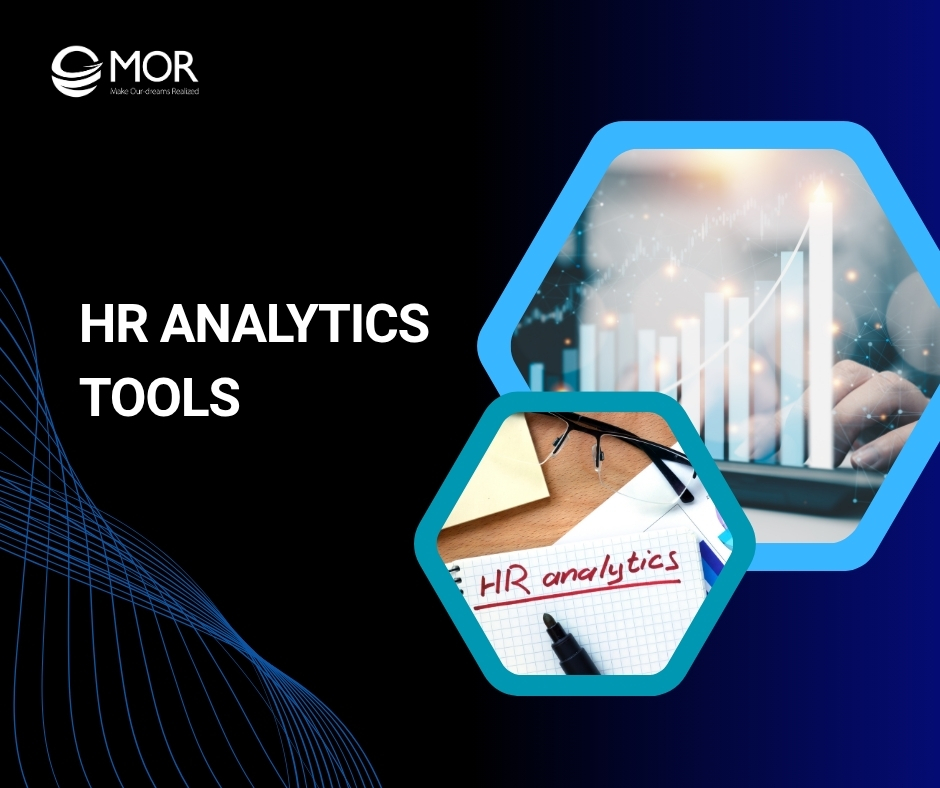
HR isn’t just paperwork anymore. It's a strategy. And smart companies are turning to HR analytics tools to guide their biggest people decisions. These platforms give teams the data they need to hire smarter, retain talent, and align HR with real business goals. In this guide, MOR Software breaks down what these tools do, why they matter, and how they’re changing the way we manage people now and into 2025.
Understanding HR Analytics Tools
To get the most out of HR analytics tools, you need to understand what they actually do and how they’ve evolved. We’ll start with the basics before exploring features, types, and real-world use.
What Are HR Analytics Tools?
HR analytics tools, sometimes called people analytics or workforce analytics, help businesses analyze workforce data to improve decision-making. They go beyond spreadsheets and guesswork. These tools collect, organize, and transform HR data into clear insights about employee performance, engagement, and productivity.
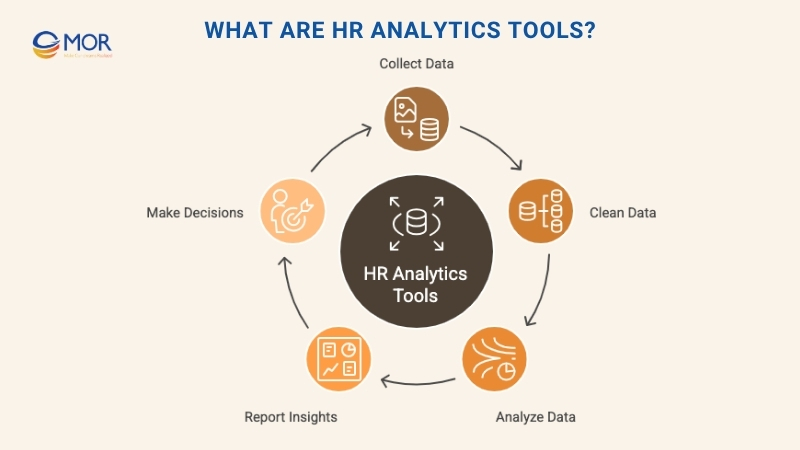
But this isn’t just about charts and dashboards. Strong HR analytics tools bring together numbers, business understanding, and people skills. Here’s what they typically help you do:
- Pull data from sources like your human resource development system, employee feedback, or performance reviews
- Clean and prepare that data so it’s ready for analysis
- Run models to detect trends, patterns, or issues
- Connect those patterns to company goals or pain points
- Share clear, useful reports with team leads or executives
A good HR analytics software supports every step. It's the engine behind better hiring, smarter workforce planning, and more strategic HR. It helps HR teams speak the same language as the C-suite, with facts, not just instincts.
Using human resource analysis tools doesn’t just improve how you track performance. It makes HR a driver of business outcomes.
How HR Analytics Has Evolved Over Time?
The role of HR analytics tools has changed fast over the last two decades. What used to be guesswork and spreadsheets has become a smart, data-first process. HR teams now use tech to understand patterns, fix problems, and plan ahead. Let’s break down the journey:
- Descriptive Analytics: This was the early phase. HR teams tracked simple numbers like staff counts, absences, or resignation rates. It answered “what happened?”
- Diagnostic Analytics: Then came the need for more context. Why were exit rates rising? Why did one team hit targets while another struggled? HR analysis at this stage focused on finding root causes.
- Predictive Analytics: Things got serious here. With the right HRM management softwares, HR leaders began forecasting trends, like future hiring needs or burnout risks, based on past behavior.
- Prescriptive Analytics: Now, tools for HR analytics go a step further. They recommend specific actions: who to promote, where to invest in training, how to structure teams.

This shift didn’t happen overnight. It came from better tools, stronger algorithms, and smarter data systems. Today, using HR analytics tool is no longer optional, it’s the new standard for modern HR teams.
Benefits of HR Analytics Tools For Organizations
HR analytics tools have moved far past trend status, they’re now a business essential. Smart companies use them to fine-tune how they hire, develop, and retain people. Why? Because data beats gut instinct every time.
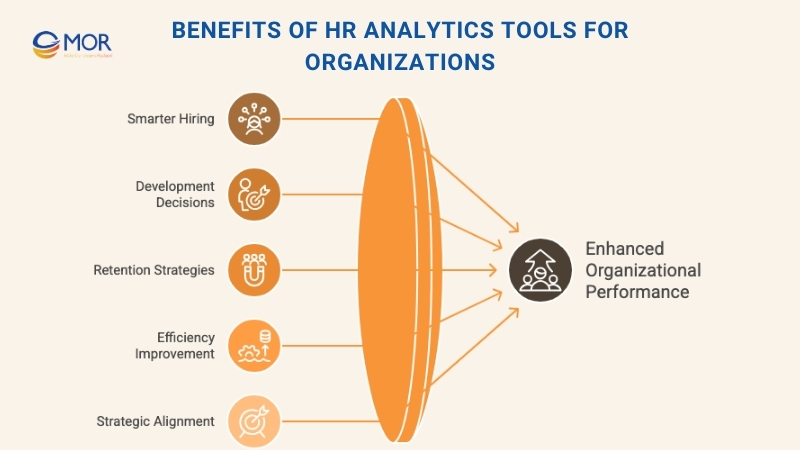
Here’s what the right HR analytics tool can do:
- Support data-backed decisions instead of guesswork or outdated rules
- Improve talent strategies across recruiting, training, and retention
- Cut waste and trim costs by spotting inefficiencies before they grow
- Upgrade the employee experience through insights on morale and engagement
- Keep HR in sync with business goals, not just admin tasks
The numbers speak for themselves. The global market for HR analytics software is projected to hit $9.9 billion by 2032, growing from $2.9 billion in 2022. It’s expected to pass $3.7 billion by 2024, growing at a CAGR of 13.4%. That kind of growth shows how seriously companies are taking workforce data.
This rise isn’t just about tech, it’s about results. As we walk through the types of best HR analytics tools, key features, and selection tips, you’ll see why this is no longer a ‘nice-to-have’. It's a must for any business looking to stay sharp.
Common Types Of HR Analytics Tools
The market is full of HR analytics tools, and the best part is that there’s an option to suit every system, budget, and business objective.
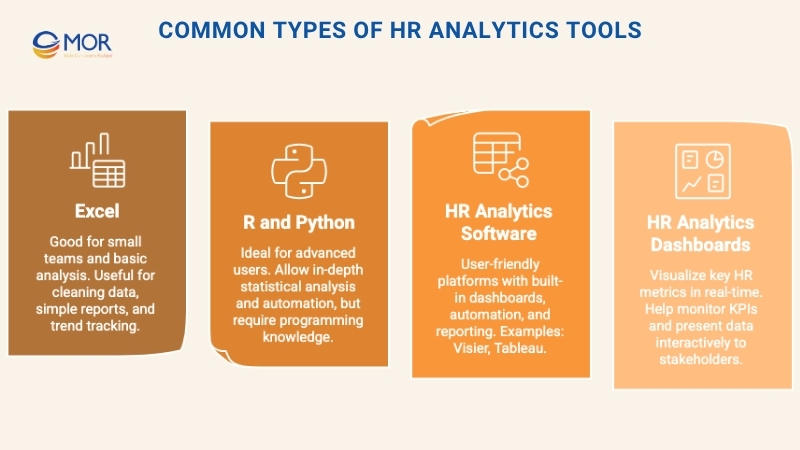
Excel
Excel might not be the flashiest choice, but it still plays a role in HR analytics tools, especially for teams starting out or working with tight budgets. Most raw HR data shows up in CSV format, which makes Excel a natural first stop.
With built-in formulas and pivot tables, you can:
- Check for messy or missing data
- Run quick calculations and summaries
- Create charts to show trends in headcount, turnover, or attendance
- Build basic reports for stakeholders
While Excel doesn’t support advanced AI automation or predictive modeling, it’s still handy for HR analysis on historical trends. It works best for small to mid-sized datasets and teams that don’t need automation or real-time sync.
If you’re not ready to invest in full-scale HR analytics software, Excel offers a no-frills, low-cost starting point. And chances are, your team already knows how to use it.
R And Python Programming Languages
R and Python aren’t HR analytics tools in the traditional sense, they’re programming languages. But in skilled hands, they’re some of the most flexible and powerful ways to handle HR data.
R is widely used for statistical analysis and data visualization. It’s perfect for running advanced models and working across all levels of HR analytics, from descriptive to prescriptive. It’s open-source too, so you won’t need to buy software.
Python is another strong choice for analyzing HR data. It’s easier to learn than R and works well for general-purpose analysis. While it’s slightly less specialized for statistics, Python is a great option if you want to automate tasks or build dashboards with tools like Pandas, NumPy, or Matplotlib.
The catch? Both options require coding skills. Most HR teams would need training or help from data analysts to make the most of them. But if you’ve got access to technical talent, or you’re working closely with a data team, R and Python can be extremely effective human resource analysis tools.
HR Analytics Software
If coding isn’t your thing and you want to skip repetitive tasks, HR analytics software is your go-to. These ready-made platforms are built to do the heavy lifting, pulling in data, processing it, and turning it into reports without much manual effort.
Most HR analytics tools in this category cover everything from basic tracking to advanced modeling. They offer built-in dashboards, filters, and reporting functions, making it easier for HR teams to focus on decisions, not data prep.
Platforms like Visier are designed specifically for people analytics. They work out of the box and come with templates, metrics, and visual reports that cover recruitment, engagement, retention, and more.
Tableau, while known for its strong visuals, also serves well for HR reporting. It takes some time to master, but compared to R or Python, it’s more beginner-friendly. Pairing Tableau with a specialized tools for HR analytics platform gives you even deeper insights, especially for large teams with growing data needs.
HR Analytics Dashboards
HR analytics dashboards are great when your priority is seeing the big picture, fast. These visual tools track key workforce metrics in real time and make it easier to spot trends, flag problems, or share updates with others.
Whether built into your HRM software development tools or created through standalone platforms, dashboards let you:
- Monitor KPIs like turnover, engagement, and hiring speed
- Drill into specific metrics to understand patterns
- Combine multiple data points for a complete view of team health
Many dashboards are interactive, so stakeholders can explore the data themselves during presentations. That makes them ideal for sharing insights with execs or department heads.
If you need a clear, flexible way to track progress and performance, dashboards are a strong fit, especially when tied to a broader HR metrics software solution.
Key Capabilities To Look For In HR Analytics Tools
Choosing the right HR analytics tools means knowing which features really move the needle. Some functions just check boxes. Others unlock serious value for your people strategy. Let’s walk through the capabilities that matter most when picking the right platform for your team.

Data Collection And System Integration
A strong HR analytics tool must be able to pull data from all your HR systems, and make sense of it. That includes everything from your HRIS and ATS to performance tracking tools and survey platforms. Integration is where it all begins.
In fact, Implementation & Integration services make up half of the total HR analytics software market, showing how central this need has become.
Top-tier best HR analytics tools offer:
- Smooth syncs with HR platforms you already use
- Support for both structured (e.g., headcount) and unstructured (e.g., comments) data
- Real-time updates without manual refreshes
- Built-in cleaning functions to spot duplicates or missing entries
- One unified data source you can trust
When all systems speak the same language, your team sees the full story, not just parts of it. That’s how better decisions get made.
Reporting And Data Analysis Features
One of the biggest strengths of any HR analytics tool is how well it helps you analyze and report your data. It’s not just about collecting numbers, it’s about making them useful.
Look for HR reporting software that gives your team flexibility and depth, including:
- Custom dashboards for quick views of key metrics
- On-demand reports you can build without IT help
- Auto-generated reports sent to the right people on a schedule
- Built-in tools for deeper statistical analysis
- Benchmarking to compare your data with industry averages
- Forecasting tools to spot future trends before they hit
These features turn raw data into clear, practical insights. Instead of just showing what’s happened, they help your team ask better questions and take smarter action. With the right tools for HR analytics, reporting becomes more than a routine, it becomes a strategy.
Tools To Monitor Employee Experience
Today’s HR analytics tools aren’t just about tracking numbers, they’re built to understand how employees feel, grow, and stay engaged. Platforms with strong employee experience features help HR teams dig deeper into what’s really driving retention and performance.
Look for tools that include:
- Pulse surveys to track sentiment in real time
- Sentiment analysis to spot patterns in feedback
- Journey mapping to follow the full employee lifecycle
- Metrics that reveal engagement levels across teams
- Feedback tools tailored to each employee
- Development tracking to monitor growth and skills over time
Adding experience data into your HR analysis paints a clearer picture of workforce health. It helps you respond to problems early, improve satisfaction, and create a workplace people want to be part of.
Predictive And AI-Enhanced Capabilities
AI is changing the way HR analytics tools work, turning raw data into smart, forward-looking insights. With the right tools, HR teams don’t just react anymore. They plan ahead.
Look for platforms that include:
- Machine learning to find hidden patterns in employee behavior
- Predictive models to flag turnover risks or hiring gaps
- NLP tools to analyze comments and open-ended feedback
- Auto-generated insights that highlight trends without digging
- Scenario planning to test “what if” situations before making changes
These AI-powered features help HR get ahead of issues, before they turn into problems. When HR analytics tool platforms combine data with intelligence, you can plan smarter, faster, and with more confidence.
Built-In Security And Compliance Functions
HR data is some of the most sensitive information a company holds. That’s why any HR analytics tool must meet strict security and compliance standards from day one.
Strong HR analytics software should include:
- End-to-end encryption for data in motion and at rest
- Role-based access controls to limit who sees what
- Full compliance with GDPR, CCPA, and other regulations
- Routine security checks and vulnerability testing
- Data masking and anonymization tools for safe analysis
- Audit trails to track every change or access point
These protections keep your data safe, and your business out of legal trouble. They also build trust with employees, knowing their info is handled responsibly.
To wrap it up, the best HR analytics tools combine smart features with secure foundations. From data integration to predictive modeling, employee experience tracking to compliance, it all matters. Choose tools that match your goals, protect your data, and help HR lead with confidence.
How To Choose The Right HR Analytics Tools For Businesses?
Picking the right HR analytics tools can shape how your business handles people, performance, and planning. With so many platforms on the market, the key is to match the software’s strengths with your specific needs. Let’s break down what to look at before making a choice.
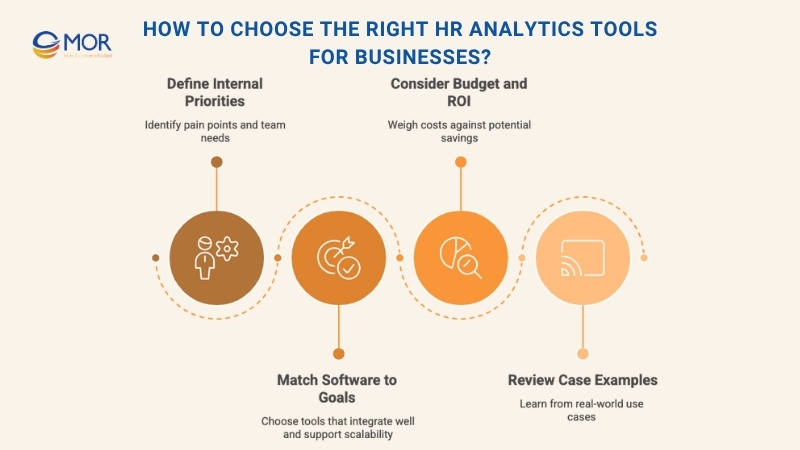
Define Your Internal Priorities And Gaps
Before shopping for a solution, look at where your team stands today, and where you want to go. Ask yourself:
- What HR processes are holding us back right now?
- What goals do we have for workforce planning or engagement?
- Do we have the data systems to support a new tool?
- How skilled is our team when it comes to analysis or reporting?
- Are we a small team with simple needs or a growing enterprise?
Between 2022 and 2032, spending on workforce planning tools is expected to grow from $0.73 billion to $2.48 billion. At the same time, HR analytics tools focused on employee engagement and development are forecasted to rise from $0.64 billion to $2.18 billion.
Those numbers say a lot: if your business cares about smart planning and employee experience, choose a tool that can handle both. A clear view of your gaps and goals will guide you toward the right HR analytics software for long-term impact.
Match Software To Your Goals And Tech Stack
Once you’ve nailed down your priorities, it’s time to match them with the right HR analytics tools. Not every solution will fit your setup, so focus on platforms that check the boxes for both features and compatibility.
Look for:
- Strong data integration that connects with your current systems
- Dashboards that are easy to use and customize
- Advanced analytics that match your goals, whether it’s hiring, retention, or compensation
- Scalability so the tool grows with your team
- Smooth compatibility with your HRIS, payroll, and performance software
Future investment trends make this even more relevant. Payroll and compensation tools are set to grow from $0.44 billion in 2022 to $1.49 billion by 2032. Recruitment analytics will rise from $0.32 billion to $1.09 billion. Retention and talent analytics are climbing too, showing a clear shift toward data-first HR decisions.
When picking HR analytics software, make sure it aligns with your current stack and future focus. The right fit means faster adoption, better results, and less friction across your HR operations.
Budget And Return On Investment Factors
Choosing HR analytics tools isn’t just about features, it’s a financial decision too. You’ll want to weigh both the initial price and the long-term payoff. Don’t just look at what it costs, look at what it could save or improve.
Key cost areas to review:
- Subscription or licensing fees
- Setup and system integration expenses
- Time and money needed for staff training
- Ongoing support and updates
Now, consider the upside:
- Fewer hiring mistakes and lower turnover costs
- Better planning that avoids over- or under-staffing
- Happier teams and improved retention
- Smarter decisions across every HR function
Tangible savings like reduced recruitment costs are easy to measure. But the intangible gains, such as improved morale or faster decision-making, are just as valuable. Over time, a well-chosen HR analytics tool pays for itself through smarter, more efficient talent management.
Case Examples From Real-World Use
Seeing how other companies use HR analytics tools can help you picture what’s possible in your own business. Real-world results often say more than product brochures. Take a look at how different industries are turning workforce data into measurable success:
- A fast-growing tech startup cut time-to-hire by 30% after switching to an AI-powered recruitment tool. Their quality of hires also went up noticeably.
- One global manufacturer used predictive models to flag top talent at risk of leaving. They lowered high-performer turnover by 20%.
- A major retail chain used engagement data to redesign benefits. Employee satisfaction jumped 15% in just one quarter.
- A financial services firm rolled out a full HR analytics software suite. Over two years, productivity across teams increased by 12% thanks to smarter, data-backed decisions.
These wins show how best HR analytics tools can make a difference, no matter the size or sector. As you compare platforms, ask vendors for case studies that match your goals. It’ll give you a clearer picture of what the tool can do beyond the sales pitch.
>>> READ MORE: Top 10 Vietnam HR Outsourcing Companies [Ranked – 2025 Edition]
Future Trends In HR Analytics Tools
The next wave of HR analytics tools is already taking shape, and it’s bringing smarter, faster, and more personalized ways to manage people. Let’s look at where things are heading and how tomorrow’s tools will reshape HR strategy.
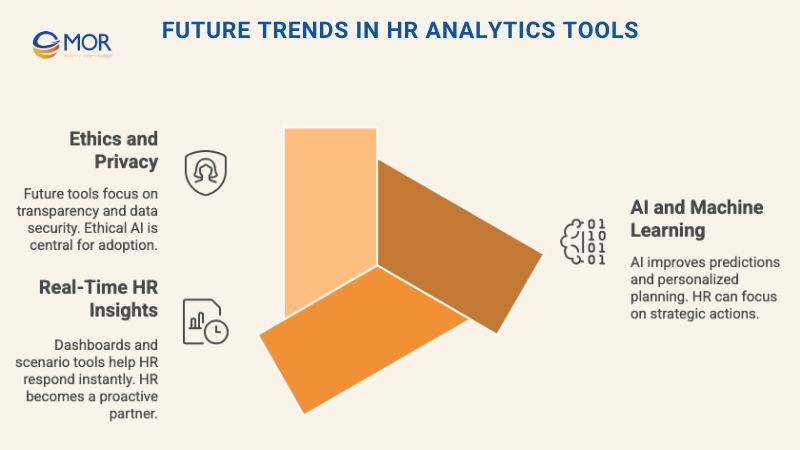
Smarter Use Of AI And Machine Learning
AI and machine learning are becoming core to modern HR analytics software, not just nice-to-have add-ons. These technologies are unlocking new levels of insight and automation across key areas:
- Predictive models are getting sharper at spotting turnover risks, growth potential, and upcoming skill gaps.
- NLP tools are digging into written feedback, from reviews, surveys, and even social platforms, to capture real-time sentiment.
- Auto-generated insights are replacing manual number crunching, letting HR teams focus on action instead of analysis.
- Personalization is also evolving. Machine learning is starting to tailor career paths, training suggestions, and compensation models based on each employee’s profile.
As these tools grow more intelligent, HR teams will spend less time sorting through data and more time making strategic moves. And that’s the real promise of AI in HR analytics tools, turning information into action at scale.
Moving From Reactive To Real-Time HR Insights
As HR analytics tools evolve, they’re shifting from tracking what already happened to helping teams act in the moment. This move toward real-time, proactive insights is reshaping how HR supports the business.
Here’s what that looks like in practice:
- Live dashboards that show changes as they happen, no more waiting for monthly reports
- Prescriptive insights that recommend what to do next, not just highlight a problem
- Always-on feedback loops, replacing static annual surveys with continuous listening
- Scenario planning tools that help model how changes in hiring, training, or org structure could affect outcomes
With these upgrades, HR becomes a strategic driver, not just a support team. The next generation of HR analytics software won’t just report problems, it’ll help solve them before they grow.
Putting Ethics And Privacy First
As HRM models get smarter, questions around privacy and ethics are becoming harder to ignore. The more data we collect, the more responsibility we have to handle it with care. Future-ready tools will need to earn trust, not just deliver insights.
Here’s where things are heading:
- Stronger data protection features like advanced encryption and anonymization to keep employee info safe
- Clear, open data policies so staff know what’s collected, how it’s used, and who has access
- Ethical AI guidelines to prevent bias in automated decisions, especially around hiring or promotions
- Employee control over personal data, including the ability to review, correct, or manage their own records
- Built-in compliance with new privacy laws and evolving global standards
The best HR analytics software of the future won’t just be powerful, it’ll be responsible. Balancing insight with integrity will set apart the companies that lead from those that lag.
Building Smarter HR Analytics Tools with MOR Software
Choosing an HR analytics tool isn’t just about picking a vendor off a list. It’s about finding a partner who understands your data challenges, your HR workflows, and your long-term goals. That’s where MOR Software comes in.
We work with HR teams to design tools that fit the way your organization actually works. From syncing data across platforms to building custom dashboards and predictive models, we turn fragmented information into useful insights you can act on.
Whether you need to analyze retention trends, measure engagement, or forecast hiring needs, we can build the systems to support it, securely, at scale, and with your team in mind.
- Custom HR dashboards tied to your metrics
- Integration with existing HRIS or ATS systems
- Real-time data pipelines and user permissions
- AI-powered models tailored to your use cases
- Full-cycle support: planning, development, and maintenance
If off-the-shelf tools don’t fit or you need something more flexible, MOR Software builds exactly what your team needs, nothing more, nothing less.
Conclusion
Using HR analytics tools is no longer optional, it’s how smart businesses manage people and plan for growth. With the right tools, you can make faster decisions, improve employee experience, and connect HR efforts directly to business results. Ready to build better analytics into your HR strategy? Contact us to explore how MOR Software can help you create smarter, data-driven solutions tailored to your goals.
MOR SOFTWARE
Frequently Asked Questions (FAQs)
What are the 4 types of HR analytics?
The four types include descriptive analytics, which explains past events, diagnostic analytics, which explores why those events happened, predictive analytics, which forecasts future outcomes, and prescriptive analytics, which suggests actions to improve HR results.
What are the basic HR analytics?
Basic HR analytics focus on collecting, organizing, and analyzing workforce data such as employee turnover, attendance, recruitment metrics, and performance scores. These insights help HR teams make informed operational decisions.
What are some examples of analytics tools?
Common HR analytics tools include Excel, Power BI, Tableau, BambooHR, Visier, intelliHR, and ChartHop. These tools help track KPIs, visualize data trends, and automate HR reporting tasks.
What are some examples of HR analytics?
Examples of HR analytics in action include tracking employee turnover rates, identifying top recruitment sources, analyzing training effectiveness, and forecasting workforce needs using historical data.
What is KPI in HR analytics?
KPI, or Key Performance Indicator, in HR analytics refers to measurable metrics like time-to-hire, employee satisfaction, retention rate, and training ROI. These help HR departments evaluate their strategies and performance.
How do HR analytics tools benefit organizations?
HR analytics tools help companies make data-driven decisions, improve hiring quality, reduce employee turnover, and increase engagement. They also support long-term workforce planning by predicting trends and identifying skill gaps.
How do I get started with HR analytics tools?
Start by defining your goals, such as reducing turnover or improving hiring. Then gather data from existing HR systems, choose a suitable analytics tool based on your needs, and train your HR team to interpret and act on the insights.
Rate this article
0
over 5.0 based on 0 reviews
Your rating on this news:
Name
*Email
*Write your comment
*Send your comment
1